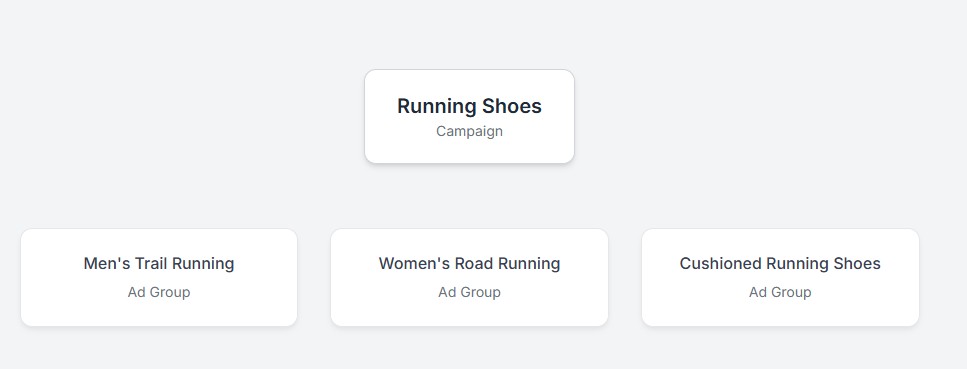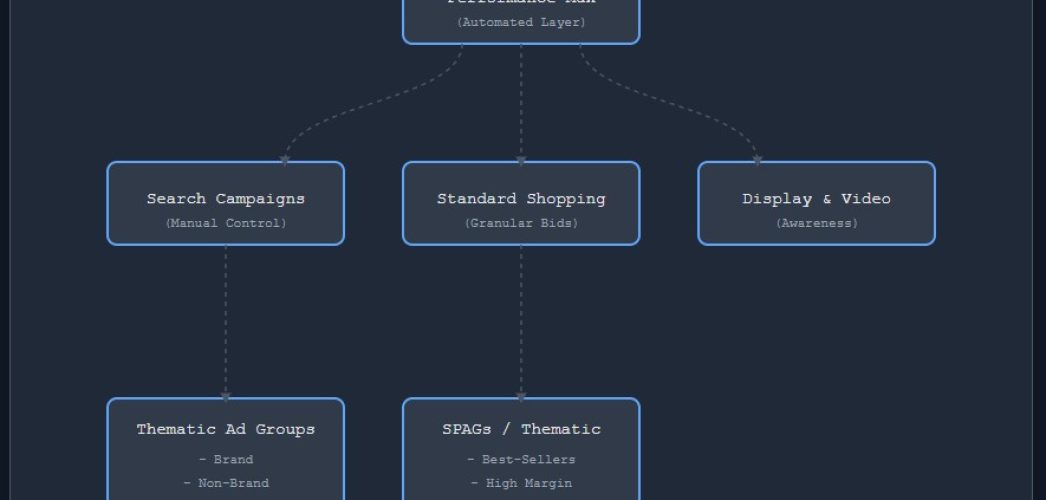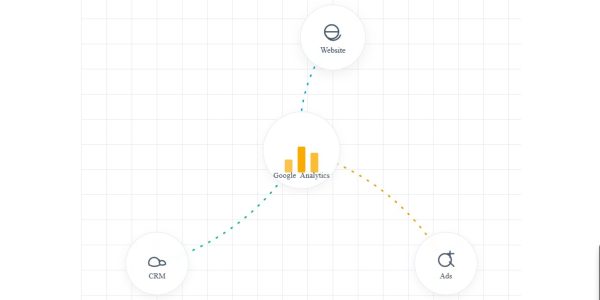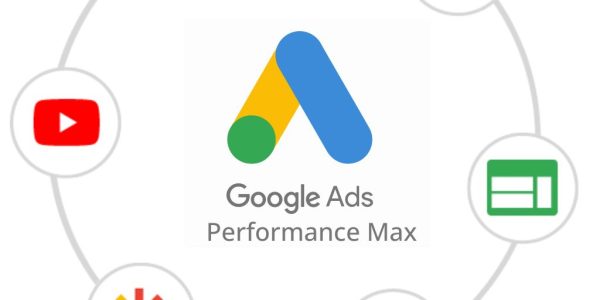Does this sound familiar? You’ve done everything by the book. You’ve tweaked your ad copy, A/B tested your landing pages, and obsessed over your Quality Score. Yet, your Google Ads performance has hit a frustrating plateau. Perhaps it’s time to explore advanced Google Ads account structures to optimize your campaigns more effectively. Your cost-per-acquisition (CPA) is creeping up, and scaling your budget feels more like burning cash than fueling growth.
The problem might not be your bids or your copy. It’s deeper. It’s in the very foundation of your account: its structure.
In today’s AI-driven advertising landscape, relying on outdated or overly simplified campaign setups is like trying to win a Grand Prix in a go-kart. To unlock the next level of performance, you need to think like an architect. You need advanced Google Ads account structures designed for precision, scalability, and profitability. This guide will show you how.

Why Your “Good Enough” Google Ads Structure is Holding You Back
For years, the gold standard was SKAGs (Single Keyword Ad Groups). The idea was simple: one keyword, one ad group, maximum relevance. But Google’s platform has evolved. With the expansion of close variant matching and the rise of machine learning, SKAGs have become inefficient and cumbersome.
Clinging to a basic structure in 2025 creates several critical problems:
- Wasted Ad Spend: Poor structure leads to internal keyword competition and inefficient budget allocation, meaning your campaigns are fighting each other for impressions.
- Murky Data: A disorganized account makes it nearly impossible to get clean, actionable data. You can’t tell what’s really working, which makes optimization a guessing game.
- Inability to Scale: A simple structure breaks down as you try to grow. Adding new products, services, or locations creates a tangled mess that’s impossible to manage effectively.
- Starving the AI: Modern features like Performance Max and Smart Bidding thrive on clear, well-organized data. A messy structure feeds them junk data, leading to suboptimal results.
It’s time to move beyond “good enough” and build a foundation for exceptional performance.
The Core Principles of Advanced Account Architecture
Before diving into specific models, it’s crucial to understand the philosophy behind them. An advanced structure isn’t just about complexity for complexity’s sake. It’s about strategic organization based on these core principles.
Granularity with a Purpose
This isn’t about creating thousands of ad groups just because you can. It’s about segmenting your campaigns and ad groups in a way that mirrors your business goals. This could be by product margin, customer lifetime value (LTV), or strategic importance. Every division should have a clear “why” behind it.
Aligning with the Customer Journey
Users search differently depending on where they are in the buying process. Your account structure should reflect this. By separating campaigns based on user intent (e.g., top-funnel research vs. bottom-funnel “buy now” intent), you can tailor your messaging, bids, and landing pages for maximum impact at each stage.
Built for Automation & AI
The future of Google Ads is a partnership between human strategy and machine learning. An advanced structure is designed to feed the AI high-quality, clearly segmented data. This empowers Smart Bidding algorithms to make better predictions and helps Performance Max understand which audience and creative combinations drive the best results.
Data-Driven Decision Making
The ultimate goal of a great structure is clarity. When your account is logically organized, your reports become infinitely more powerful. You can easily see which product lines are most profitable, which geographic areas are underperforming, and where your greatest opportunities for growth lie.
Exploring Advanced Google Ads Account Structures (Models & Blueprints)
There is no single “best” structure; the right one depends on your business model, goals, and resources. Here are some of the most powerful and proven advanced Google Ads account structures used by top-tier advertisers.
Here is an introduction to Google Ads campaign types
1. The Thematic Structure (Consolidated & Intent-Based)
This is the modern successor to SKAGs. Instead of focusing on a single keyword, you group a small set of tightly-related keywords into a “theme” within a single ad group.
- How it works: An ad group might be themed around “men’s trail running shoes” and contain keywords like
trail running shoes for men,men's off-road running sneakers, andbest trail runners for men. All ads and the landing page would be hyper-focused on this specific theme. - Best for: Most lead-gen and e-commerce businesses. It balances control with manageability and works exceptionally well with Smart Bidding.
- Pros: Much easier to manage than SKAGs, provides excellent data for Google’s AI.
- Cons: Requires meticulous keyword research and a robust negative keyword strategy to prevent overlap between themes.

2. The Full-Funnel Structure (Awareness, Consideration, Conversion)
This structure segments campaigns based on the marketing funnel, targeting users with different messaging based on their intent.
- How it works:
- Top of Funnel (ToFu – Awareness): Broad, informational search terms (e.g.,
how to prevent running injuries). Often supported by Display or YouTube campaigns. The goal is reach and branding, not direct sales. - Middle of Funnel (MoFu – Consideration): More specific, comparison-based keywords (e.g.,
hoka vs brooks running shoes,best running shoes for flat feet). The goal is to provide value and become the preferred solution. - Bottom of Funnel (BoFu – Conversion): High-intent, transactional keywords (e.g.,
buy nike pegasus 41 online,running store near me). This includes Brand search and Remarketing campaigns. The goal is to close the sale.
- Top of Funnel (ToFu – Awareness): Broad, informational search terms (e.g.,
- Best for: Businesses with a longer sales cycle or those investing heavily in content marketing.
- Pros: Allows for holistic budget management across the entire customer journey. Nurtures leads effectively.
- Cons: Can be complex to set up and requires different creative/messaging for each stage.
Here is the guide on the marketing funnel from Hubspot.
3. The SPAG (Single Product Ad Group) Structure for E-commerce
For e-commerce advertisers using Standard Shopping campaigns, SPAGs offer the ultimate level of control.
- How it works: As the name implies, each ad group contains only a single product (SKU). This allows you to set a specific bid, monitor performance, and add negative keywords at the individual product level.
- Best for: E-commerce stores with a wide range of products and varying margins. Especially powerful for isolating and pushing your bestsellers.
- Pros: Unmatched granular control over product-level bidding and reporting.
- Cons: Extremely time-consuming to create and manage manually. Often requires third-party software or scripts to implement at scale.
4. The Alpha/Beta Campaign Structure
A classic advanced strategy that’s still relevant, the Alpha/Beta structure is designed for keyword discovery and optimization.
- How it works:
- Beta Campaigns: Use broad match keywords with Smart Bidding to “fish” for new, high-performing search queries. Budgets are controlled, and the goal is discovery.
- Alpha Campaigns: Contain only your proven, top-converting keywords as exact match. These are your money-makers. You bid aggressively and assign them the majority of the budget.
- When a search query in a Beta campaign proves profitable, you add it as an exact match keyword to the corresponding Alpha campaign and as a negative keyword to the Beta campaign to prevent overlap.
- Best for: Mature accounts with large budgets looking to scale efficiently while controlling costs.
- Pros: Systematically finds new opportunities while protecting the performance of your best keywords.
- Cons: Requires diligent monitoring of the Search Terms Report and consistent management.
Integrating Performance Max into Your Advanced Structure
Performance Max (PMax) isn’t just another campaign type; it’s a full-funnel solution that layers across your entire account. Integrating it effectively without cannibalizing your existing campaigns is key.
The secret is to not let PMax run wild. Guide it.
- Structure Your Asset Groups: Don’t just dump all your assets into one group. Treat Asset Groups like you would ad groups. Create tightly-themed groups based on product categories, services, or user personas. For example, have a separate Asset Group for “Trail Running Shoes” and another for “Road Racing Flats.”
- Use Audience Signals Intelligently: This is your primary way to guide PMax’s AI. Feed it your most valuable data: your first-party customer lists, website visitors (remarketing), and custom segments built around users who have searched for your competitors’ terms.
Managing the complex interplay between PMax and your granular Search campaigns can be a significant challenge. At Infineural Technologies, we leverage proprietary strategies to ensure your PMax campaigns create a synergistic lift, complementing your core search efforts rather than competing with them.
How to Choose and Implement the Right Structure
Ready to rebuild? Not so fast. A successful transition requires a strategic approach.
- Audit Your Current Account: Before you build something new, you need a blueprint of what you already have. Where are the inefficiencies? Which campaigns have the messiest data? Identify your biggest pain points.
- Define Your Business Goals: The best structure is one that aligns with your primary objective. Are you an e-commerce store focused on ROAS? A B2B company focused on lead quality? A local business focused on foot traffic? Your goal dictates your structure.
- Start Small & Test: Never tear down and rebuild your entire account at once. Pick one campaign or product line to serve as a pilot. Use Google Ads Experiments to run your new structure against the old one. Let the data prove the concept before rolling it out account-wide.
The process of planning and migrating to one of these advanced Google Ads account structures can be complex and carries risk if not executed perfectly. If you’re looking for an expert hand to guide your transition and unlock your account’s true potential, the team at Infineural Technologies specializes in just that. We architect and implement bespoke Google Ads structures that drive measurable, sustainable growth.
From Plateau to Peak Performance
Moving beyond a basic setup is no longer a luxury for the top 1% of advertisers—it’s a necessity for any business that wants to grow profitably on Google Ads.
The right account structure brings order to chaos. It provides the clarity you need for sharp insights, the control you need for precise optimization, and the foundation you need to effectively leverage Google’s powerful AI. It’s the single most impactful change you can make to break through your performance plateau.
Feeling overwhelmed by the complexity but excited by the potential? That’s the first step toward mastery. To get a clear, actionable plan tailored to your business, let’s talk.
Schedule a free, no-obligation Google Ads Strategy Call with an Infineural Technologies expert today. We’ll analyze your current structure and show you exactly where your hidden opportunities for growth are waiting.


